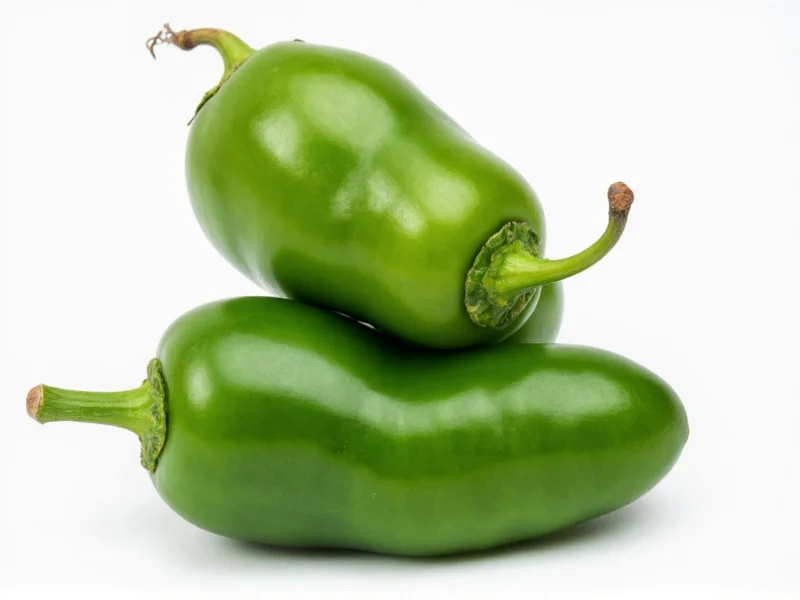The Scoville heat unit (SHU) range for jalapeño peppers is 2,500 to 8,000 units. This places jalapeños in the mild to medium heat category on the Scoville scale, making them one of the most commonly used hot peppers in cooking worldwide.
Understanding exactly what is the scoville of a jalapeno requires examining both the measurement system and the natural variability of these popular peppers. The Scoville scale, developed by pharmacist Wilbur Scoville in 1912, measures the concentration of capsaicinoids—the compounds responsible for a pepper's heat.
Understanding the Scoville Heat Unit Measurement
The Scoville scale quantifies pepper heat through a dilution test. Originally, it measured how many times capsaicin extract needed dilution in sugar water before the heat became undetectable to a panel of tasters. Today, high-performance liquid chromatography (HPLC) provides more precise measurements, though results are still converted to Scoville Heat Units for consumer understanding.
Why Jalapeños Have a Range Rather Than a Single Value
When exploring how hot is a jalapeno on the Scoville scale, it's important to recognize that numerous factors influence heat levels:
- Ripeness: Green jalapeños (less ripe) tend to be milder than red jalapeños (fully ripe)
- Growing conditions: Soil composition, climate, and water stress affect capsaicin production
- Genetic variation: Different jalapeño cultivars have varying heat potentials
- Individual pepper differences: Even on the same plant, heat can vary significantly
Comparing Jalapeño Heat to Other Common Peppers
To better understand jalapeno pepper heat level in context, consider this comparison of common peppers:
| Pepper Type | Scoville Heat Units (SHU) | Relative Heat Level |
|---|---|---|
| Bell Pepper | 0 SHU | No heat |
| Jalapeño | 2,500-8,000 SHU | Mild to medium |
| Serrano | 10,000-23,000 SHU | Medium to hot |
| Habanero | 100,000-350,000 SHU | Very hot |
| Ghost Pepper | 855,000-1,041,427 SHU | Extremely hot |
Practical Implications of Jalapeño Heat Levels
Knowing the specific jalapeno Scoville units range helps in culinary applications. At 2,500-8,000 SHU, jalapeños provide noticeable heat without overwhelming other flavors, making them versatile for:
- Salsas and sauces where balanced heat is desired
- Stuffed peppers that maintain structural integrity during cooking
- Pickled preparations that mellow the heat slightly
- Adding subtle warmth to dishes without dominating other ingredients
For those sensitive to spice, removing the seeds and white pith (where most capsaicin concentrates) can significantly reduce the perceived heat while maintaining jalapeño flavor.
Factors That Increase Jalapeño Heat
Several environmental factors can push jalapeños toward the higher end of their jalapeno scoville heat range:
- Water stress: Mild drought conditions increase capsaicin production
- Soil nutrients: Lower nitrogen levels can intensify heat
- Sun exposure: More direct sunlight generally increases capsaicin
- Ripening time: Fully mature red jalapeños are typically hotter than green ones
Commercial growers sometimes manipulate these factors to produce jalapeños with more consistent heat levels for specific markets.
Measuring Heat Perception vs. Scientific Measurement
It's worth noting that individual heat perception varies significantly. Two people eating the same jalapeño might experience different heat levels due to:
- Genetic differences in capsaicin receptor sensitivity
- Previous exposure to spicy foods (building tolerance)
- Food consumed alongside the pepper (fats and sugars reduce heat perception)
- Individual pain threshold variations
While the scientific measurement of what is the scoville of a jalapeno remains consistent at 2,500-8,000 SHU, personal experience of that heat can differ substantially.
Historical Context of Jalapeño Cultivation
Jalapeños originated in Mexico, where they've been cultivated for thousands of years. The name comes from Jalapa (or Xalapa), the capital city of Veracruz state. Unlike many specialty peppers, jalapeños have achieved global popularity while maintaining their characteristic heat profile through careful cultivation practices.
Using Jalapeños Appropriately in Cooking
Understanding the precise jalapeno scoville heat level helps home cooks and professional chefs alike:
- For milder dishes: Use younger green jalapeños and remove seeds/membranes
- For medium heat: Use mature green jalapeños with some seeds
- For maximum heat: Use fully ripe red jalapeños with seeds intact
- When substituting: Remember that serranos are 2-3 times hotter than jalapeños
Roasting jalapeños not only enhances their flavor but can also slightly reduce perceived heat by breaking down some capsaicin compounds.
How does the heat of a jalapeño compare to a bell pepper?
Jalapeños range from 2,500-8,000 Scoville Heat Units, while bell peppers register at 0 SHU. This means jalapeños are measurably spicy while bell peppers contain no capsaicin and have no heat.
Why do some jalapeños taste hotter than others?
Variations in heat come from multiple factors including ripeness (red jalapeños are typically hotter than green), growing conditions, specific cultivar, and even position on the plant. Individual peppers from the same plant can vary significantly in heat level.
Can I reduce the heat of a jalapeño before cooking with it?
Yes, removing the seeds and white pith (placenta) significantly reduces heat, as these parts contain the highest concentration of capsaicin. Soaking sliced jalapeños in salt water or milk for 15-30 minutes can also mellow the heat while preserving flavor.
How does cooking affect jalapeño heat?
Cooking can both concentrate and dissipate heat. Roasting or grilling jalapeños caramelizes sugars while breaking down some capsaicin, potentially reducing perceived heat. However, when making sauces or salsas, the heat can become more evenly distributed and sometimes seem more intense.
Are red jalapeños just ripe green jalapeños?
Yes, red jalapeños are simply fully ripened green jalapeños. As they mature and change color, they typically develop a slightly sweeter flavor profile and can be somewhat hotter than their green counterparts, though they remain within the standard 2,500-8,000 SHU range.











 浙公网安备
33010002000092号
浙公网安备
33010002000092号 浙B2-20120091-4
浙B2-20120091-4